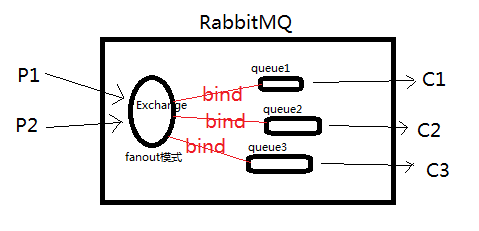一、
消息的广播需要exchange:exchange是一个转发器,其实把消息发给RabbitMQ里的exchange
fanout: 所有bind到此exchange的queue都可以接收消息,广播
direct: 通过routingKey和exchange决定的那个唯一的queue可以接收消息
topic:所有符合routingKey(此时可以是一个表达式)的routingKey所bind的queue可以接收消息
headers:通过headers来决定把消息发给哪些queue,用的比较少
原理图:

发布者端:
''' 发布者publisher ''' import pika import sys connection = pika.BlockingConnection(pika.ConnectionParameters('localhost')) channel = connection.channel() channel.exchange_declare(exchange='logs', # exchange名字为logs type='fanout') # 通过命令行自己输入消息,没输入就是hello world message = ' '.join(sys.argv[1:]) or "info: Hello World!" # 广播不需要写queue,routing_key为空 channel.basic_publish(exchange='logs', routing_key='', body=message) print("send :", message) connection.close()
订阅者端:
''' 订阅者subscriber ''' import pika connection = pika.BlockingConnection(pika.ConnectionParameters('localhost')) channel = connection.channel() channel.exchange_declare(exchange='logs', type='fanout') # 不指定queue名字,rabbit会随机分配一个唯一的queue, # exclusive=True会在使用此queue的消费者断开后,自动将queue删除 # 发送端没有声明queue,为什么接收端需要queue?看上面原理图就明白 result = channel.queue_declare(exclusive=True) # 拿到的随机的queue名字 queue_name = result.method.queue # 需要知道从哪个转发器上去收所以需要绑定 channel.queue_bind(exchange='logs', queue=queue_name) print("Wait for logs...") def callback(ch, method, properties, body): print("received:", body) channel.basic_consume(callback, queue=queue_name, no_ack=True) channel.start_consuming()
运行结果:
''' 先启动发布者,再启动订阅者,为什么订阅者收不到信息? 原理类似于收音机收听广播: 订阅者相当于收音机,发布者相当于广播信号 所以这个接收是实时的,订阅者启动之后,才能收到发布者发出的广播 '''